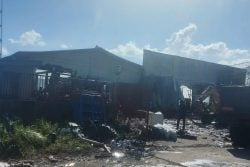DHAKA (Reuters) – Bangladesh textile workers vented their anger yesterday, burning cars and clashing with police, as the death toll passed 300 following the collapse of a building housing factories that made low-cost garments for Western brands.
Miraculously rescuers were still pulling people alive from the rubble – 72 since daybreak following 41 found in the same room overnight – two days after the eight-storey building collapsed on the outskirts of the capital, Dhaka.
But there were fears that hundreds of people were still trapped in the wreckage of the building, which officials said had been built illegally without the correct building permits.
“Some people are still alive under the rubble and we are hoping to rescue them,” said deputy fire services director Mizanur Rahman.
A spokesman for Prime Minister Sheikh Hasina said she had ordered the arrest of the owners of the building and of the five factories that occupied it.
Army spokesman Shahinur Islam said the death toll had reached 304 and H. T. Imam, an adviser to the prime minister, said it could exceed 350.
Anger over the working conditions of Bangladesh’s 3.6 million garment workers, the overwhelming majority of them women, has grown steadily since the disaster, with thousands taking to the streets to protest on Friday.
About 2,350 people have been rescued, at least half of them injured, from the remains of the building in the commercial suburb of Savar, about 30 km (20 miles) from Dhaka.
An industry official has said 3,122 people, most of them female garment workers, had been in the Rana Plaza building despite warnings that it was structurally unsafe.
Emdadul Islam, chief engineer of state run Capital Development Authority (CDA), said that the owner of the building had not received the proper building consent, obtaining a permit for a five-storey building from the local municipality, which did not have the authority to grant it.
“Only CDA can give such approval,” he said. “We are trying to get the original design from the municipality, but since the concerned official is in hiding we cannot get it readily.”
Furthermore, another three storeys had been added illegally, he said. “Savar is not an industrial zone, and for that no factory can be housed in Rana Plaza,” Islam told Reuters.
Bangladesh is the second-largest exporter of garments in the world but many factories remained closed for a second day on Friday, with garment workers protesting against poor conditions and demanding the owners of the building and the factories it housed face harsh punishment.
Police and witnesses said protesters set fire to a number of vehicles and damaged other garment factories.
Dhaka District police chief Habibur Rahman identified the owner of the Rana Plaza building as Mohammed Sohel Rana, a leader of the ruling Awami League’s youth front.
Imam, the prime minister’s adviser, said Rana had “vanished into thin air”.
“People are asking for his head, which is quite natural. This time we are not going to spare anybody,” Imam said.
Wednesday’s collapse was the third major industrial incident in five months in Bangladesh. In November, a fire at the Tazreen Fashion factory on the outskirts of Dhaka killed 112 people.
“This incident is devastating for us as we haven’t recovered from the shock of Tazreen fire yet,” said Finance Minister Abul Maal Abdul Muhith, who visited the site yesterday.
Such incidents have raised serious questions about worker safety and low wages in Bangladesh and could taint the poor South Asian country’s reputation as a producer of low-cost products and services.





